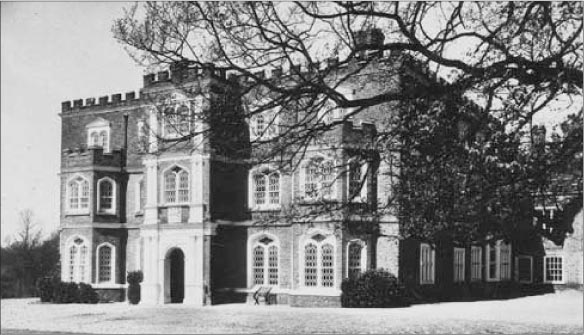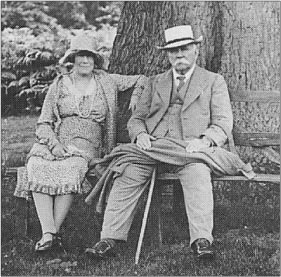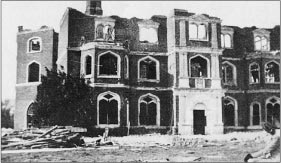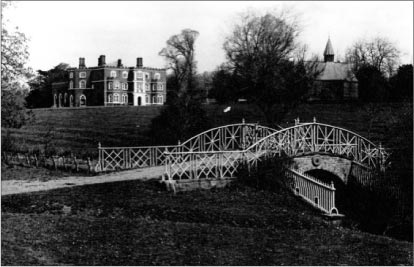MARKS HALL AND THE PHILLIPS PRICE TRUST

Marks Hall near Coggeshall (circa 1930).
The Marks Hall estate just north of Coggeshall had belonged to the Honywood family for almost 300 years when it was bought by Thomas Phillips Price in 1897. The estate was famous for the splendour of its Jacobean House and gardens and in particular for the magnificence of the oak trees in its park.
When Phillips Price died on June 28th 1932, he left Marks Hall and the surrounding estate of about 2000 acres to the nation “for the advancement of agriculture, arboriculture and forestry”, specifying that the management of the estate should be put under the control of the Director of the Royal Botanic Gardens Kew. He furthermore expressed the desire that the house itself should be occupied by whoever should be Director of Kew at the time. Unfortunately, as it turned out, he also left a life interest to his third wife, May Elizabeth, who outlived him by 34 years. By the time she died in 1966, part of the estate had been turned into an airfield, the house had been demolished and the vast majority of the oak trees cut down. Not surprisingly, Kew was tempted to look this gift-horse in the mouth. In the end it didn’t; the nation has come into its inheritance and a new arboretum is gradually taking shape on the site of the former park.
Following the Norman conquest, the manor of Markshall became part of the estate of Hugh de Montfort and it was the descendants of one of his tenants who adopted the name of Markshall as their surname. De Montfort’s estates having been confiscated, they were given to Hugh de Essex, a notably undistinguished Standard Bearer to Henry II. Morant, in his history of Essex, tells us that during an expedition that the king made into Wales, Hugh “behaved very unworthily, throwing down the standard and cowardly running away; which so animated the Welsh and discouraged the English, under an apprehension of the king’s being slain, that the whole army was utterly routed”. Having been charged with treason and vanquished in trial by combat he was fortunate that the king spared his life but, thereafter, “partly thrust, partly going into a convent, (he) hid his head in a cowl under which between shame and sanctity he blushed out the remainder of his life”. His lands, unsurprisingly, were confiscated and the manor of Markshall granted to the Markshalls, descendents of the tenants at the time of the conquest. They managed to retain ownership for four hundred years until 1562. After a short period when it belonged to the Cole and Deraugh families, the estate was bought by Robert Honywood in 1605 and it remained in the possession of successive generations of the talented Honywood family up to the end of the nineteenth century. In 1897, acrimonious law suits over the succession led to the sale to Thomas Phillips Price.
Robert Honywood pulled down the front of the tudor house and replaced it in 1609 with an impressive brick front in the Jacobean style. Above the elaborately decorated porch his arms impaled those of Browne of Beachworth Castle in Kent, the family he had married into. Christopher Hussey, in an article in Country Life dated September 1923, refers to the appearance of Marks Hall as “being well calculated to whet the curiosity”. This is a considerable understatement. Phillips Price was, with reason, extremely proud of his country seat and approved the publication of two articles in Country Life dealing firstly with the gardens and next with the house. The illustrations to the latter article shew the interior to have been quite exceptional, in particular the superb Jacobean hall as well as the later Georgian dining room and gothic room.

Thomas Phillips Price with his third wife May under one of the great oaks. (Thomas Phillips Price Trust)
More celebrated than Robert Honywood was his mother, Mary Waters, of whom there is a portrait in the Colchester Castle museum and about whom there are a number of well-worn stories. She lived to see 367 living descendants – 16 children, 114 grandchildren, 228 great grandchildren and 9 great great grandchildren. Mary Waters apparently suffered from religious melancholia and amongst those who attempted to comfort her was John Fox the author of the eponymous Book of Martyrs. According to Morant, Fox’s ministrations having been of no avail, she took up a Venetian glass saying “I am as surely damn’d as this glass is broken”. Thereupon she threw the glass “with violence to the ground, but the glass rebounded and was taken up whole and entire”. In spite of this apparent miracle she remained as disconsolate as before, but then at last, “God suddenly shot comfort like lightening into her soul” and she lived out the remainder of her days “in spiritual gladness”. In 1933, the Essex Review published a picture of the glass which had been discovered in Ireland in the possession of one of Mary Waters’s descendants.
Sir Thomas Honywood, Robert’s son, was knighted by Charles I but nevertheless became a parliamentarian and played a prominent part at the siege of Colchester when the Royalists were besieged in the town. It is said that the parliamentary army, while encamped at Marks Hall, were employed digging the lakes to keep them out of mischief. After the Royalist surrender, Sir Thomas was left in charge of the town with orders to demolish the walls, which fortunately he failed to do. In 1651 he commanded a regiment of Essex men at the battle of Worcester. At a key point in the battle, the Essex militia stormed and captured a redoubt called Fort Royal and turned the royalist guns to fire on Worcester, thus making the royalist position untenable. Worcester was a disaster for the king and put an end to the Second Civil War. At the Restoration Honywood was nevertheless granted a royal pardon.
The Honywood family produced a number of successful soldiers of whom the most famous was General Philip Honywood whose huge portrait by Gainsborough (10ft x 10ft 8 inches) shows him in his scarlet uniform with drawn sword and atop his favourite charger. (The picture is now in the John & Mabel Ringling Museum of Art in Sarasota, USA). The general did all in his power to preserve the estate, the house and its contents for future generations of Honywoods. In particular he stipulated in his will that any of his successors who failed to take the name Honywood within 3 months of inheriting the estate or who felled timber other than for repairs on the estate should forfeit the property. As a result, the oaks in the park were so carefully looked after that, by the end of the nineteenth century, they were amongst the finest in the country.
In 1859, William Philip Honywood died without issue and to avoid the estate going to his brother, a notorious gambler, he left it to his wife for her lifetime and then to a godson, fearing that otherwise within 6 months “there will not be a timber tree left on the estate”. Endless lawsuits followed, leading ultimately to the sale of the estate, the house and its entire contents.
Thomas Price was a Welshman who in his early twenties inherited a substantial fortune from his uncle Sir Thomas Phillips. Having for some time led the life of a country gentleman, he entered politics and sat in the House of Commons as member for North Monmouthshire for ten years. Needing a base within reach of London, in 1898 he bought Marks Hall, a house suitable to a man of his standing with fourteen principal bedrooms, two lakes and a deer park. He embarked immediately on a programme of improvement to the estate which had become run down while the various Honywood claimants concentrated on fighting each other in the courts.
Phillips Price married for the first time in 1884 but his wife died in 1896 and he married again in 1898. His second wife suffered from chronic ill health and died in 1926. Undaunted, he was married again in 1927, this time to May Elizabeth Swann who had been his sister’s companion and was aged 51. He was already 83.
As far back as 1907, Phillips Price had been worrying about what would happen to Marks Hall after his death. In September of that year he wrote to the then director of Kew Gardens, Colonel Prain, as follows “I am the owner of this estate which is richly wooded, principally with oak, some of them very fine trees – I have no children – and after the death of my wife, I should like to leave the estate to the Kew Garden Authorities, to be maintained by them for ever, on condition that they preserved the timber, the income of the Estate to be used for this purpose for the sake of Arboriculture. I want to know whether the Kew Gardens Authorities are capable of holding such an Estate on such conditions…My object is that the timber should be preserved as far as it is possible to preserve it”.
At the time there was considerable public concern about the effect of pollution from coal smoke on the plants at Kew and Phillips Price evidently envisaged the possibility of moving the botanic gardens to Marks Hall. In 1927, in anticipation of his marriage to his third wife, Phillips Price made a new will which shewed that his concerns about the estate had not in any way changed over the course of the previous 20 years, although the estate was only to go to Kew if he failed to have any children. Almost every paragraph refers to the possibility that he might have children and yet his wife to be was 51. Perhaps it is just the legalese in which the will is inevitably written but, reading it, one is tempted to wonder whether he was acquainted with the facts of life. Alternatively, he may have been under the impression that his wife was a great deal younger than she was, although from photographs this seems unlikely. The third paragraph of the will reads “I appoint my dear wife May Elizabeth during her life and after her death my trustees to be the Guardian and Guardians of any infant children I may leave”. Again and again in the will the possibility of sons or daughters or both is referred to. Ultimately the will deals with the possibility that he will not have children in which case the estate is left to Kew.
Underlining Phillips Price’s near obsession with the oak trees, the very next paragraph, before dealing with the house, deals with the timber “And as the timber on my Essex estate has been preserved with great care for centuries and is of exceptional size and beauty, it is my wish (except in the woods where the Timber will be dealt with in a due course of Forestry) that no timber shall be cut on my Essex estate except from dead trees and I wish my trustees so far as may be possible to see that no such timber (except as aforesaid) is cut during the life of my said wife.” The inability to cut down any trees 138 years previously, had caused the then owner of the estate, Filmer Honywood, to bring forward an Act of Parliament to allow the felling of dead and decaying trees and the thinning of younger wood. (He was not entirely motivated by the need to keep the oaks in good condition as there was a £8750 mortgage to be redeemed which was financed from the sale of timber).
Quite apart from his enthusiasm for the park, the oaks and the gardens, Phillips Price comes across as exceptionally generous both to his wider family and to his employees. His relations and god-children having been well provided for in his will, he left £500 each to his carpenter, his driver, his gardener, his gamekeeper and his butler. The head housemaid got £200 and the under gamekeeper £150. (In a codicil dated some two and a half years later, the bequest to his housemaid was revoked…) The bequests reflect his keen interest in the gardens and the shooting which perhaps meant even more to him than the house.
After his death in June 1932, the estate, almost inevitably, fell into decline. The 1920s and 30s were a terrible time for agriculture and Mrs Phillips Price, who had no children, had only been left a life interest, so she had little incentive to spend money on upkeep. Furthermore, she may have felt relatively badly off because of her
husband’s rather generous bequests. Phillips Price’s Welsh estate, which benefited from the income derived from several coal mines, had been left to the Royal Gwent Hospital in Newport. It is said that the fact that his wife had only been left a life interest came as a considerable shock to her, although why is unexplained. What had she intended doing with the estate if she had been left it without strings? From her portrait she looks an unlikely fortune hunter. But perhaps she genuinely felt short of cash and would just have liked to have lived on a rather more lavish scale than turned out to be possible. In any event, her husband’s will made it quite clear how important it was to him that the estate and in particular the trees were looked after. But they were not.
Within a few months of Phillips Price’s death, the church which stood only a few yards from the house, was demolished. The church had become redundant following the amalgamation of the parish with that of Coggeshall and the decision to demolish it had been taken before Phillips Price’s death. Mrs Price, who would then have been only 56, is said to have disliked the church as her predecessor, the second Mrs Price, had been buried there. The demolition caused considerable public protest. “How comes it,” the Essex County Standard demanded melodramatically “that a parish church should secretly be blotted out by a gang of navvies which came over the fields like a thief in the night?” It was claimed that the church was “stout, solid and substantial with 3 foot (thick) walls.”
And then came the war. Mrs Price moved out of the house and into Marygolds, a dower house on the estate which she had retained in her own name. Like most large houses in East Anglia, Marks Hall was requisitioned, part of the estate had Earls Colne airfield built on it, large numbers of huts and other buildings were erected and the house became the headquarters of the United States Ninth Army Air Force. The airfield became operational in spring 1943 and losses were heavy. In June, on a single mission over Kiel, 9 Flying Fortresses were shot down over the North sea and 80 crew lost. In one month of operational flying, the squadrons lost half of their original aircraft and 150 men.

Marks Hall – the final act.
The US Air Force was succeeded by the RAF, but following the end of the war Marks Hall’s travails did not cease as Braintree Rural District Council then requisitioned the huts erected by the Air Force to house displaced persons wished on them by the Ministry of Health. By 1949, as a result of vandalism, the house was alleged to have become dangerous, the fittings were stripped and sold and in 1950 the house was demolished. Questions were asked in parliament and the Chancellor of the Exchequer asked if members were aware that the house was listed Grade 1 and had been bequeathed to the nation. Lord Euston, writing in The East Anglian Magazine in 1953, said the house “had been carefully looked after while occupied by the United States Air Force and the RAF during the war, but was afterwards so badly damaged by local hooligans while standing empty that it has been demolished”. Those hooligans can only have been displaced persons housed in the neighbouring huts by Braintree RDC. It seems likely that the Council, encouraged by the Ministry of Health, had herded together problem families within their jurisdiction and dumped them in the former air force huts without making proper provisions to protect the house.

The iron bridge with house and church in background.
In 1956 came the final insult. The deer park with its famous oaks was leased to the Forestry Commission for 999 years. Under the terms of Phillips Price’s will the proceeds of any sale of timber were to be counted as income and therefore accrued to Mrs Price. Virtually all the oaks were cut down.
Phillips Price’s will made crystal clear his desire to protect the oaks, so why did his executors not intervene? One of the two executors, Phillips Price’s brother-in-law, Major General John Christopher Swann had died in May 1939 and the other, Arthur Graham, would have been in his nineties. (I can find no trace of his death). No replacement executors seem to have been appointed. Mrs Phillips Price, who was by then 80, lived on in Marygolds, but she had become very deaf and was virtually housebound.
Braintree RDC should have intervened to protect the house, but they did not and seem instead to have hastened its demise. Similarly, the Forestry Commission failed to protect the oaks in their single-minded determination to plant conifers.
In 1966, having moved into a nursing home in Bournemouth, Mrs Price died at the age of 90 and Thomas Phillips Price’s bequest became effective. After extensive discussions, Kew decided to accept the bequest and, in 1971, The Thomas Phillips Price Trust was established to manage the estate, the trustees being appointed by the Ministry of Agriculture. In 1972 the trustees decided to create an arboretum of national status within the former park and the Forestry Commission were persuaded to release sufficient land to make this possible.
By now – 2010 – the lakes have been repaired, the walled garden restored and there has been extensive replanting. Only one of the huge Honywood oaks remains and vast amounts of work remain to be done, but a new arboretum is arising phoenix-like from the undergrowth. The trustees are doing their best to see that as far as is possible Phillips Price’s intentions are put into effect.
One can go from Boulogne to Athens” says Oliver Rackham, “without seeing a tree more than 200 years old. But at least since Shakespeare the English have loved the beauty and mystery of ancient trees. Ancient trees are full of meanings which young and middle aged trees do not have at all and it has become the duty of the English to cherish them”.
Jeremy Hill
Marks Hall is situated just north of Coggeshall in the angle between the A120 and the B1024 to Earls Colne. The Gardens and Arboretum are open April to October, Tuesday to Sunday; on Bank holiday Mondays and on winter weekends including Fridays from 10.30am to dusk. For further details consult www.markshall.org.uk
Jeremy Hill has, once again, written another very interesting article. Marks Hall has featured in our “Places of Special Interest” on our website, since very soon after I set up the site. The garden is well worth a visit and there is a good selection of plants for sale, and a good restaurant.
